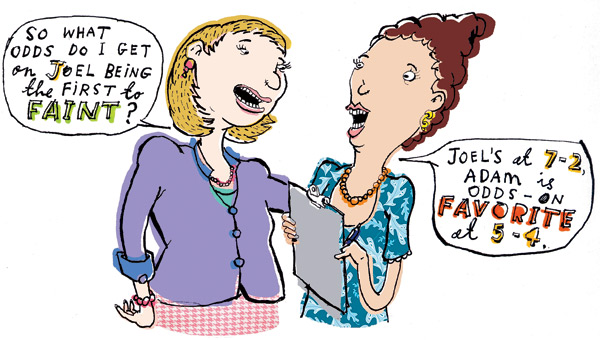
“You’re going to another bris?” a friend asked recently. “What goes down at those things, anyway? I mean . . . apart from the obvious.” Ah, the timeless comedy of circumcision. Certain things are inherently funny, like baboons, Zambonis, and lederhosen, but the bris—that ancient Jewish ceremony wherein a room full of half-delighted, half-horrified people watch an unsuspecting infant get snipped—is king. The Closer highly recommends attending one, unless it’s your own, but if you don’t have the chutzpah to be a bris crasher, allow me to give you the tour.
1. The invitation. There is none. For Closer Jr.’s bris, we simply sent out an e-mail announcing the time and place, and allowed the guest list to grow by word of mouth. Why? Attending a bris is a commandment, so new parents don’t put their friends in a position to turn it down. The real reason, though, is that the prophet Elijah, who attends every bris, always forgets to RSVP, so they just ditched invitations altogether.
2. The kvatter. Once the guests arrive, the kvatter (literally, “the person honored by bringing the baby”) plucks the eight-day-old from his ashen mother’s arms. The kvatter is usually an uncle who has no kids of his own and, hence, no clue how to carry a baby. This marks the first of many times that the kid will wish he hadn’t trusted his uncle.
3. The sandek. Next to handle the baby is the sandek (“godfather”). This is often the kid’s grandfather, whose main tasks are to shift uncomfortably in his seat, to hold the child during the ceremony, and to look guilty for his role in the bloodshed.
4. The mohel. The “ritual circumciser” is always a bearded geezer with a name like Yakov Blumenfeld or Shlomo Lipschitz. Circumcision, the mohel explains, is significant because God told Abraham, who was 99 at the time: “You shall circumcise the flesh of your foreskins, and it shall be a sign of the covenant between me and you.” It’s also financially significant: For 30 minutes of work, the mohel gets $500. Plus a free meal.
5. “It used to be a fiveskin.” As the child is placed on a chair reserved for Elijah, the crowd jockeys for position. Hoary jokes ripple through the room: “It won’t be long now . . .” Various children in attendance, sensing that something is not right, have stopped playing to gape at the izmel, the mohel’s razor-sharp surgical knife. “They’re doing what? ” I heard an incredulous boy ask. “Jeez! Why?”
6. The final cut. The mohel lays the baby on the lap of the sandek, who places a wine-soaked piece of gauze on the boy’s tongue to distract him. The mohel quickly removes the child’s foreskin, tears off and folds back the mucous membrane to expose the glans, then suctions blood from the wound.
7. Someone faints. It’s always a man.
8. The aftermath. The mohel announces the child’s Hebrew name, and asks for someone to distribute wine. For the first time, the room is silent. “Never ask for a volunteer at a bris,” he quips. The baby gets a drop or two of wine for his trouble before he’s returned to his mother, who will never let go of him again.
9. The meal. Bagels and lox for everyone! The jokes resume around the deli tray: “How much do you tip a mohel?” “Oh, about an inch.” Never gets old.
10. The kid. Falls asleep and is forgotten until his bar mitzvah.
Illustration by David Fullarton


